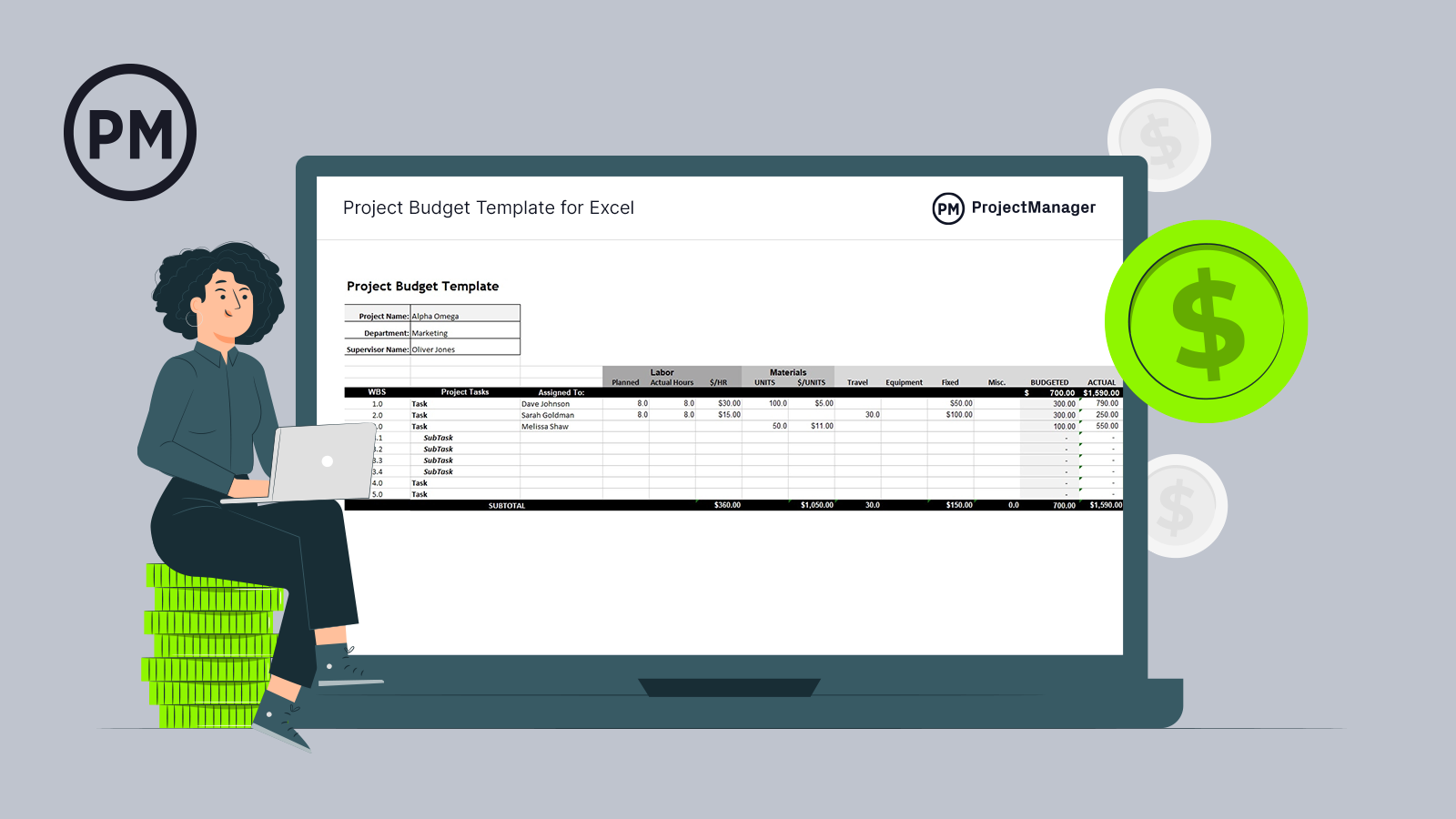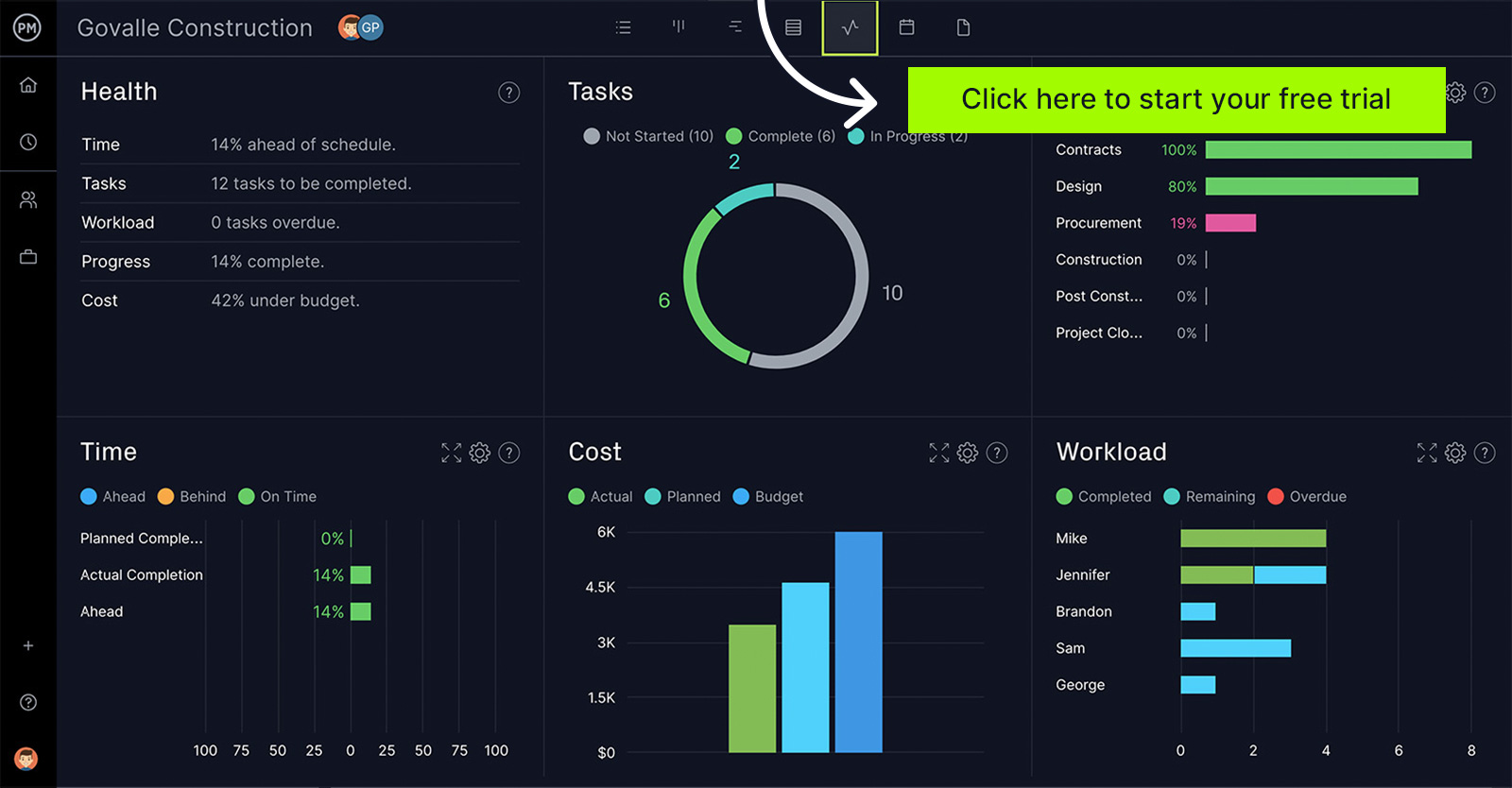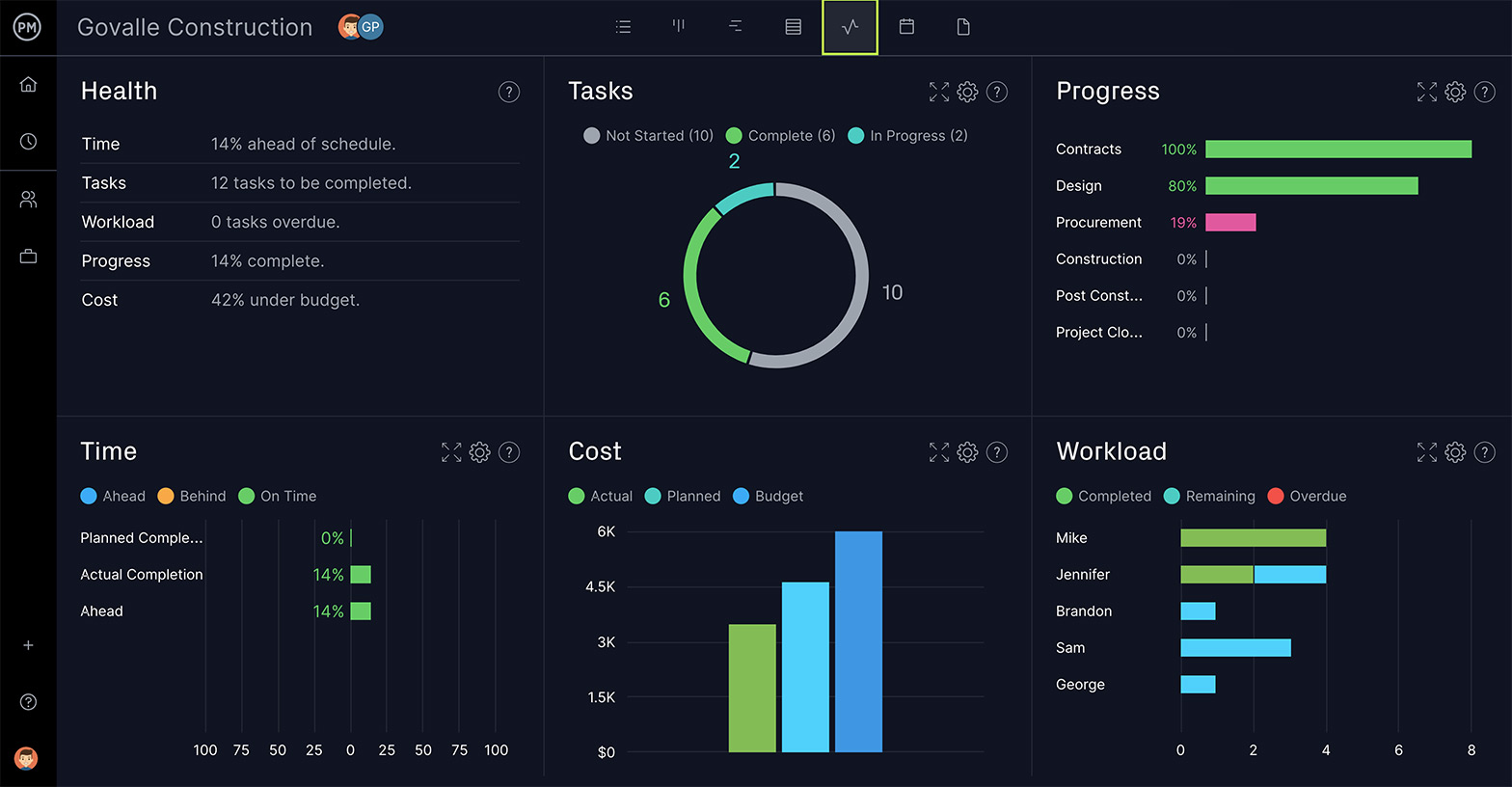Even the most meticulously planned projects experience unforeseen changes, and when this happens, we need to quantify the effect these changes have. Luckily, there are formulas that eliminate the guesswork.
One of these formulas solves for Estimate at Completion — an important metric for monitoring a project budget. Keep reading to learn why to always calculate Estimate at Completion and exactly what this formula can do.
What Is Estimate at Completion (EAC)?
Estimate at completion (EAC) is a part of the earned value management (EVM) system. This term refers to the practice of re-estimating the total cost of the project during the project execution phase. In other words, EAC allows project management teams to forecast how much the project will cost at the time of completion based on its actual costs, which are likely different from the costs in the project budget made in the initiation or planning phase.
Once calculated, the EAC can then be compared to the originally projected budget to determine if the project is likely to be finished within budget based on current performance.
Unlike other methods of cost estimation, an estimate at completion calculation considers actual performance at any given moment of the project execution phase and recognizes that initial budget projections are likely not perfect. For this reason, it is often referred to as a “project forecasting tool or method”


Get your free
Project Budget Template
Use this free Project Budget Template for Excel to manage your projects better.
To fully understand the role EAC plays in the earned value management system, we have to look at other parts of this system and how EAC is unique.
Because of the dynamic nature of EAC, there is no single formula to calculate the estimate at completion of a project, as you can use several formulas depending on how the project is progressing. But before we get into that, it’s important to define the variables that are used to calculate EAC.
Estimate at Completion (EAC) Definitions
The estimate at completion formula consists of variables and concepts that are part of the Earned Value Management system. But what exactly do these terms mean and how do you find them?
- Budget at Completion (BAC): Budget at Completion (BAC) refers to the entire budget required to complete a project. In order to find BAC, you must add all estimated costs and expenses. Generally, budgets are broken down categorically. BAC is the sum of all the categories.
- Cost Performance Index (CPI): Cost Performance Index (CPI) is a ratio representing how costs are being turned into actual work; how effectively is money being spent. This is found by dividing the earned value (EV) of work completed by the Actual Cost (AC) it took to perform.
- Schedule Performance Index (SPI): Similar to CPI, the Schedule Performance Index measures how efficiently time is being spent. SPI is calculated by dividing the Earned Value (EV) of work done by the Planned Value (PV).
- Estimate to Complete (ETC): ETC forecasts the expected cost to complete the remaining project work. It helps project teams determine how much more funding is needed, either by subtracting actual costs from the EAC or through a new bottom-up estimate.
- Actual Cost (AC): AC represents the total cost incurred for completed work up to a specific point in time. It is used in Earned Value Management to assess how much has been spent compared to the value of the work performed.
- Budget at Completion (BAC): BAC is the total budget originally approved for the entire project. It serves as the financial baseline and is used to measure cost performance and forecast deviations from planned expenditures throughout the project life cycle.
- Earned Value (EV): EV is the budgeted value of work actually completed at a given point in time. It quantifies progress in financial terms and is essential for calculating cost and schedule performance in Earned Value Management.
- Planned Value (PV): PV is the authorized budget assigned to scheduled work. It reflects how much of the budget should have been spent based on the project schedule and is used to evaluate whether the project is on track.
Additional Estimate at Completion Formulas
Estimates at completion can also be calculated in three other ways, and each of the variations is best for a certain situation.
This formula should be used when the difference between the estimated budget and actual costs will be different in the future than it is in the present:
Estimate at Completion = Actual Cost + (Budget at Completion – Earned Value)
This formula is the best choice when production has been steady and things are running smoothly. Using this formula helps confirm that a project is on track to stay within budget:
Estimate at Completion = Actual Cost + (Budget at Completion – Earned Value)
When it’s necessary to take project schedule and cost performance into account (how efficiently time and money are being used) to revise a budget, use this formula to find estimates at completion. As you can see, you first need to calculate the Schedule Performance Index and Cost Performance Index.
Estimate at Completion = Actual Cost + (Budget at Completion – Earned Value) / Schedule Performance Index + Cost Performance Index
How to Calculate Estimate at Completion: Estimate at Completion Formulas
Here are the formulas used to calculate the estimate at completion of a project. Each of them allows project management teams to estimate how much a project will cost at the end, but are slightly different to accommodate various scenarios.
1. EAC = BAC/CPI
We’re happy to report that the most commonly used estimate at completion formula is fairly simple! In order to calculate the estimate at completion (EAC), you must know the budget at completion (BAC) and the cost performance index (CPI). With this information, the calculation is as simple as dividing the two.
Below is what that estimate at completion formula looks like in more detail:
Estimate at Completion = Budget at Completion / Cost Performance Index
This formula assumes that the cost performance seen so far will continue throughout the rest of the project. It’s used when the project is stable and trends in cost efficiency are expected to remain consistent.
Because it directly factors in the Cost Performance Index (CPI), it’s best for projects with predictable spending patterns and no major disruptions. It allows teams to adjust expectations without re-estimating each task, making it ideal for consistent, ongoing performance evaluation.
2. EAC = AC + (BAC – EV)
This formula is the best choice when production has been steady and things are running smoothly. It assumes that past cost overruns or inefficiencies were one-time events, and the remaining work will be completed as originally budgeted. It’s most useful when early cost variances are not expected to continue and the original plan still holds for future work.
Below is what that estimate at completion formula looks like in more detail:
Estimate at Completion = Actual Cost + (Budget at Completion – Earned Value)
This formula does not adjust for ongoing performance trends, so it’s best used when there’s confidence that the baseline plan is still realistic. It’s a conservative forecast based on reverting to the initial budget.
3. EAC = AC + [(BAC – EV) / (CPI × SPI)]
This estimate at completion formula should be used when it’s necessary to take project schedule and cost performance into account (how efficiently time and money are being used) to revise a budget.
It adjusts for both cost and schedule performance, assuming that future work will be influenced by current inefficiencies in both areas. It’s especially valuable for troubled or complex projects where delays and overspending are occurring together.
Below is what that estimate at completion formula looks like in more detail:
Estimate at Completion = Actual Cost + [(Budget at Completion – Earned Value) / (Schedule Performance Index * Cost Performance Index)]
By incorporating both the Cost Performance Index (CPI) and the Schedule Performance Index (SPI), it produces a more comprehensive forecast. It’s best used when neither cost nor time trends can be ignored, and recovery requires simultaneous attention to both factors.
4. EAC = AC + Bottom-up ETC
This approach assumes that the original plan is no longer valid, and a new estimate must be built from the ground up. It’s used when significant changes in scope, unexpected challenges, or shifts in project direction occur.
Below is what that estimate at completion formula looks like in more detail:
Estimate at Completion = Actual Cost + Bottom-up Estimate to Complete
Instead of relying on performance indices, this method involves a detailed reassessment of remaining tasks and costs. It’s best for projects requiring a fresh financial outlook due to poor initial planning, changing requirements, or disrupted performance metrics that render previous estimates unusable.
Estimate at Completion Example
For this example, we’ll use the first Estimate to Complete formula variation. As a reminder, here’s what that equation looks like:
EAC = BAC / CPI
In this scenario, the Budget at Completion (BAC) is $50,000 and the current Cost Performance Index (CPI) is equal to 0.8. Therefore, we must divide $50,000 by 0.8.
EAC = $50,000 / 0.8
EAC = $62,500
This result indicates that at the current moment, the project is estimated to cost $62,500, which is $12,500 over the initial budget.
Estimate at Completion vs. Estimate to Complete
These two terms are often mixed up, because they both refer to estimates on some aspect of a project budget. Because they are so easily confused, it’s key to know the difference and when to calculate for which.
Estimate at completion (EAC) predicts total costs, while estimate to complete (ETC) predicts the money a project still needs. ETC is the forecast of all additional money required to complete a project. It does not account for money already spent.
Estimate at Completion vs. To Complete Performance Index (TCPI)
The term “to complete performance index” (TCPI) refers to how cost-efficient the rest of a project must be in order to complete the final deliverable. This is a subset of a cost performance index (CPI). A CPI shows how efficiency costs and resources are being used in the present.
When we solve for CPI, the answer will be less, greater or equal to one, depending on how costs compare to the amount of work completed.
If, for instance, CPI is less than one, changes need to be made in order to be more cost-efficient. When this is the case, you will solve for TCPI to find a numerical value representing how much this adjustment needs to be.
That formula looks like this:
TCPI = (Budget at Completion (BAC) – Earned Value (EV)) / (BAC – Actual Cost (AC))
Why Is it Important to Calculate the Estimate at Completion of a Project?
Even the most well-planned budgets aren’t always 100% accurate. Projects are prone to changes and unexpected circumstances, including increased or decreased expenses and costs.
Calculating EAC gives project managers the opportunity to track exactly how much a change will impact the total budget — in a dollar amount. Knowing this exact dollar amount makes for better, more informed decision-making.


When to Calculate the Estimate at Completion of a Project
Estimate at completion is a means of estimating how much a project will cost at the end of the line. But, in order to accurately calculate for EAC, you need to know the cost performance index (CPI). As such, EAC can only be calculated when a project is running.
The CPI is calculated at regular intervals during a project, as this number shows spending effectiveness. This makes it a good habit to calculate for EAC anytime the CPI changes.
Project Budget Template
Before you calculate EAC, you’ll need to create a thorough project budget. This free project budget template for Excel allows you to list all your project tasks and their related costs such as labor, material and equipment. The best part is that it automatically calculates the difference between planned and actual costs to let you know whether your project is over or under budget.
However, while this project management template is useful, it can’t compete with the features of a robust project management software like ProjectManager.
How ProjectManager Helps with Cost Estimating and Variance
When you’ve successfully calculated the Estimate at Completion, it’s time to put the results to use. In order to make the best estimates, you need to have the most current information. The ProjectManager dashboard updates in real-time, so there’s no chance of using old data to make important decisions for the future.
Use a wide range of filters to customize the dashboard view to your liking and hone in on the critical details. See costs, tasks, time spent and overall project health, all from one hub.
Let your dashboard do the calculations for you and easily compare things like planned v. actual costs, planned completion v. actual completion and more. That means there’s no need to get out the calculator or rely on third-party applications to see things like your EAC.
Related Content
When creating an estimate at completion for your project, you need the best tools to calculate cost estimations and variance. ProjectManager is a cloud-based project management software with dashboards and resource management features that give you control over your project costs. Try ProjectManager today for free!








